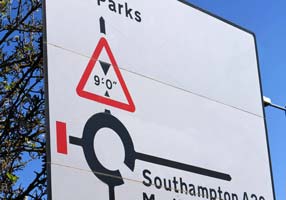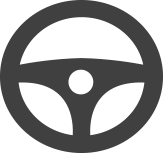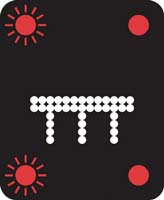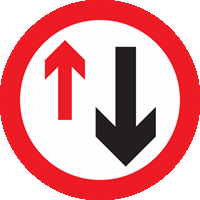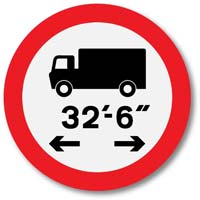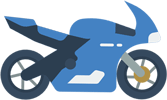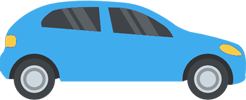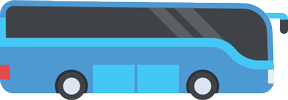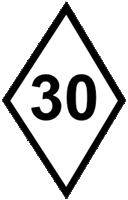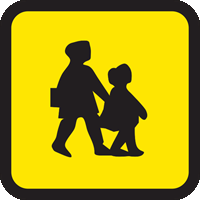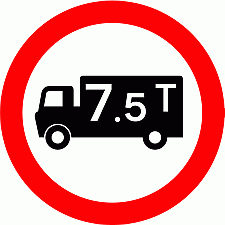You have 115 minutes (1 hour 55 minutes) to answer 100 multiple choice PCV theory test questions. You must score at least 85 out of 100 to pass the test. Answers may be checked after each question or you can wait until the end of the test to view your results. Good luck!
Test Quick View
Click on an answer to view the correct choice along with the explanation.
1. In which of the following might vehicles over a certain length be restricted from entering?
Mark one answer
B
C
D
Correct Answer: C
Explanation: Look out for restrictions on long vehicles. Length restrictions are found where there isn't much room to turn (for example, in a tunnel) or where there's a risk of grounding.
Explanation: Look out for restrictions on long vehicles. Length restrictions are found where there isn't much room to turn (for example, in a tunnel) or where there's a risk of grounding.
Correct Answer: A
Explanation: Look out for signs giving you advance warning of height restrictions. As a professional driver, you should always know the height of your vehicle or load. If you aren't sure of the safe height, stop and check.
Explanation: Look out for signs giving you advance warning of height restrictions. As a professional driver, you should always know the height of your vehicle or load. If you aren't sure of the safe height, stop and check.
Correct Answer: D
Explanation: It's essential that all wheel nuts are tightened to the specified torque with a calibrated torque wrench. The wheel nuts, fixings and markers should be checked every day before you start your journey.
Explanation: It's essential that all wheel nuts are tightened to the specified torque with a calibrated torque wrench. The wheel nuts, fixings and markers should be checked every day before you start your journey.
Correct Answer: D
Explanation: A tachograph allows you to select the mode or task that you're undertaking. Time spent on that task is then recorded automatically. Each task has a different symbol. You need to know the meaning of each, so that your records are correct. The modes are: driving, doing other work, on duty and available for work, and taking a break or rest.
Explanation: A tachograph allows you to select the mode or task that you're undertaking. Time spent on that task is then recorded automatically. Each task has a different symbol. You need to know the meaning of each, so that your records are correct. The modes are: driving, doing other work, on duty and available for work, and taking a break or rest.
Correct Answer: B
Explanation: If you're driving for long distances on a motorway, have plenty of rest stops. Many incidents have been caused by drivers falling asleep at the wheel. If you feel yourself becoming tired, you need to leave the motorway and find a safe place to stop; usually this would be the next service area.
Explanation: If you're driving for long distances on a motorway, have plenty of rest stops. Many incidents have been caused by drivers falling asleep at the wheel. If you feel yourself becoming tired, you need to leave the motorway and find a safe place to stop; usually this would be the next service area.
B
C
D
Correct Answer: A
Explanation: If you don't give your name and address at the time of an incident, report it to the police as soon as you can, or in any case within 24 hours. If any other person is injured and you don't produce your insurance certificate to the police at the time of the incident, or to any other person who has reasonable grounds to request it, you must also
Explanation: If you don't give your name and address at the time of an incident, report it to the police as soon as you can, or in any case within 24 hours. If any other person is injured and you don't produce your insurance certificate to the police at the time of the incident, or to any other person who has reasonable grounds to request it, you must also
- report the incident to the police as soon as possible, or in any case within 24 hours
- produce your insurance certificate to the police either when reporting the incident or within seven days (five days in Northern Ireland) at any police station.
Correct Answer: D
Explanation: You can help someone suffering from shock by talking to them and reassuring them confidently. Don't leave them alone or give them anything to eat or drink.
Explanation: You can help someone suffering from shock by talking to them and reassuring them confidently. Don't leave them alone or give them anything to eat or drink.
8. Why would you move an unconscious casualty that is still breathing following an accident?
Mark one answer
B
C
D
Correct Answer: A
Explanation: Moving a casualty could cause further injury, so it's important that this is only done if there's danger to them where they are.
Explanation: Moving a casualty could cause further injury, so it's important that this is only done if there's danger to them where they are.
Correct Answer: B
Explanation: When driving large vehicles, windscreen pillars and large mirrors can easily create blind spots as you look left and right at junctions. Altering your body position slightly while looking into the new road can give you an improved view of the traffic. If in doubt, look again and reassess the situation. Don't take chances.
Explanation: When driving large vehicles, windscreen pillars and large mirrors can easily create blind spots as you look left and right at junctions. Altering your body position slightly while looking into the new road can give you an improved view of the traffic. If in doubt, look again and reassess the situation. Don't take chances.
Correct Answer: A
Explanation: By using a bypass, rather than joining the stop/start traffic in a town centre, you're less likely to be held up and can travel at a constant speed. Keeping to a constant speed will reduce the amount of pollution produced by your vehicle.
Explanation: By using a bypass, rather than joining the stop/start traffic in a town centre, you're less likely to be held up and can travel at a constant speed. Keeping to a constant speed will reduce the amount of pollution produced by your vehicle.
Correct Answer: C
Explanation: Fuel spilled on the road is a serious danger to other road users, especially motorcyclists. To prevent this from happening, make sure the filler cap is secure after refuelling.
Explanation: Fuel spilled on the road is a serious danger to other road users, especially motorcyclists. To prevent this from happening, make sure the filler cap is secure after refuelling.
Correct Answer: A
Explanation: When the red lights are flashing, don't go beyond this signal. This sign shows that all lanes ahead are closed and you mustn't enter the motorway. Motorway signals are located on the central reservation, to the left of the hard shoulder, on overhead gantries and at the entrance to the motorway.
Explanation: When the red lights are flashing, don't go beyond this signal. This sign shows that all lanes ahead are closed and you mustn't enter the motorway. Motorway signals are located on the central reservation, to the left of the hard shoulder, on overhead gantries and at the entrance to the motorway.
Correct Answer: C
Explanation: When you see this sign, you must give way to traffic from the opposite direction, regardless of the size of your vehicle.
Explanation: When you see this sign, you must give way to traffic from the opposite direction, regardless of the size of your vehicle.
Correct Answer: D
Explanation: You need to know the length of your vehicle as well as its weight, height and width. Places where the length of your vehicle may be relevant are
Explanation: You need to know the length of your vehicle as well as its weight, height and width. Places where the length of your vehicle may be relevant are
- road tunnels
- level crossings
- ferries
- bridges.
B
C
D
Correct Answer: D
Explanation: In wet conditions, water can build up between your tyres and the road surface. This is known as aquaplaning and it will cause your vehicle to slide. Try to regain control by easing off the accelerator to gradually lose speed. Don't brake or steer until your tyres are gripping the road again.
Explanation: In wet conditions, water can build up between your tyres and the road surface. This is known as aquaplaning and it will cause your vehicle to slide. Try to regain control by easing off the accelerator to gradually lose speed. Don't brake or steer until your tyres are gripping the road again.
Correct Answer: B
Explanation: Tyres have codes shown on the wall of the tyre. These refer to the maximum load and speed capability of the tyre.
Explanation: Tyres have codes shown on the wall of the tyre. These refer to the maximum load and speed capability of the tyre.
Correct Answer: B
Explanation: Your vehicle will make more noise than a car, so you should try to avoid making unnecessary noise at any time of the day or night. This is especially important when you're in a residential area at a time when people are likely to be sleeping.
Explanation: Your vehicle will make more noise than a car, so you should try to avoid making unnecessary noise at any time of the day or night. This is especially important when you're in a residential area at a time when people are likely to be sleeping.
18. Which of the following medical conditions might stop you from getting a bus or lorry license?
Mark one answer
B
C
D
Correct Answer: C
Explanation: An illness that could affect you while you're driving, such as a heart condition, may make it unsafe for you to drive. You must tell DVLA if you develop any serious illness or disability that's likely to last more than three months and that could affect your driving. Partial blindness and mental disorders can also prevent you from getting a driving licence for large vehicles.
Explanation: An illness that could affect you while you're driving, such as a heart condition, may make it unsafe for you to drive. You must tell DVLA if you develop any serious illness or disability that's likely to last more than three months and that could affect your driving. Partial blindness and mental disorders can also prevent you from getting a driving licence for large vehicles.
Correct Answer: C
Explanation: When your steering wheels are locked - as can happen in a skid - you can't steer the vehicle. Anti-lock brakes help you to keep steering control while you're braking heavily, but they aren't a substitute for good forward planning. Anticipation and planning ahead will minimise the risk of skidding more effectively than relying on your braking system.
Explanation: When your steering wheels are locked - as can happen in a skid - you can't steer the vehicle. Anti-lock brakes help you to keep steering control while you're braking heavily, but they aren't a substitute for good forward planning. Anticipation and planning ahead will minimise the risk of skidding more effectively than relying on your braking system.
B
C
D
Correct Answer: B
Explanation: The car is the most stable of the vehicles shown. However, all vehicles are affected by side wind and buffeting from larger vehicles. Be aware that your speed and road position could cause unnecessary turbulence when passing smaller vehicles.
Explanation: The car is the most stable of the vehicles shown. However, all vehicles are affected by side wind and buffeting from larger vehicles. Be aware that your speed and road position could cause unnecessary turbulence when passing smaller vehicles.
Correct Answer: A
Explanation: During high winds, one of the lanes on a high bridge might be closed to traffic to create a buffer lane. The buffer lane is kept free to prevent vehicles from being blown into the path of other road users in the next lane. The closure of this lane may cause traffic congestion and delay.
Explanation: During high winds, one of the lanes on a high bridge might be closed to traffic to create a buffer lane. The buffer lane is kept free to prevent vehicles from being blown into the path of other road users in the next lane. The closure of this lane may cause traffic congestion and delay.
22. Which of the following type of vehicle is likely to be most affected by your vehicle as a result of turbulence?
Mark one answer
B
C
D
Correct Answer: B
Explanation: remember that the buffeting caused by large vehicles can affect other road users, including
Explanation: remember that the buffeting caused by large vehicles can affect other road users, including
- cars towing caravans
- motorcyclists.
Correct Answer: B
Explanation: In very windy conditions, certain types of vehicle can be blown off course. These include box vans, curtain-siders, caravans and motorcycles. Make allowances for how the wind might affect these vehicles, especially if you're overtaking.
Explanation: In very windy conditions, certain types of vehicle can be blown off course. These include box vans, curtain-siders, caravans and motorcycles. Make allowances for how the wind might affect these vehicles, especially if you're overtaking.
24. Where should you be especially wary of side winds when driving a high-sided vehicle on a motorway?
Mark one answer
B
C
D
Correct Answer: D
Explanation: On motorways, be especially careful when driving over bridges and viaducts. The road here is exposed and in windy weather there's a risk of strong side wind, which may blow you off course or even blow your vehicle over. In severe windy weather, these routes are often closed to drivers of high-sided vehicles.
Explanation: On motorways, be especially careful when driving over bridges and viaducts. The road here is exposed and in windy weather there's a risk of strong side wind, which may blow you off course or even blow your vehicle over. In severe windy weather, these routes are often closed to drivers of high-sided vehicles.
25. How could faulty spray-suppression equipment negatively affect other drivers in wet conditions?
Mark one answer
B
C
D
Correct Answer: D
Explanation: Spray-suppression equipment reduces the amount of spray thrown up to other road users. Check the equipment regularly to make sure it's secure and undamaged.
Explanation: Spray-suppression equipment reduces the amount of spray thrown up to other road users. Check the equipment regularly to make sure it's secure and undamaged.
26. What might cause your steering to feel less responsive while driving in heavy rain on the motorway?
Mark one answer
B
C
D
Correct Answer: A
Explanation: If a build-up of water prevents the tyres from gripping the road, the steering can become unresponsive. If this happens, ease off the accelerator and slow down gradually.
Explanation: If a build-up of water prevents the tyres from gripping the road, the steering can become unresponsive. If this happens, ease off the accelerator and slow down gradually.
27. What should you do if you see the brake air-pressure warning light when you start driving?
Mark one answer
B
C
D
Correct Answer: C
Explanation: Even though the warning light is showing, there may be sufficient pressure to release the parking brake. However, you mustn't do this, because there may not be enough air pressure to operate the service brake.
Explanation: Even though the warning light is showing, there may be sufficient pressure to release the parking brake. However, you mustn't do this, because there may not be enough air pressure to operate the service brake.
Correct Answer: A
Explanation: Pedestrians use push-button controls to activate the signals. Pelican crossings have no red-and-amber stage before green. Instead, they have a flashing amber light. This means you must give way to pedestrians on the crossing, but you may proceed if the crossing is clear.
Explanation: Pedestrians use push-button controls to activate the signals. Pelican crossings have no red-and-amber stage before green. Instead, they have a flashing amber light. This means you must give way to pedestrians on the crossing, but you may proceed if the crossing is clear.
Correct Answer: D
Explanation: When traffic is heavy, plan well ahead so that you don't block crossings. Leave them clear so that pedestrians can cross safely.
Explanation: When traffic is heavy, plan well ahead so that you don't block crossings. Leave them clear so that pedestrians can cross safely.
B
C
D
Correct Answer: C
Explanation: Tiredness can seriously affect your concentration - even to the point of falling asleep. You always need to be alert so that you can safely deal with the constantly changing environment around your vehicle.
Explanation: Tiredness can seriously affect your concentration - even to the point of falling asleep. You always need to be alert so that you can safely deal with the constantly changing environment around your vehicle.
31. What should you do if you're offered alcohol at an event, but will be driving home later?
Mark one answer
B
C
D
Correct Answer: B
Explanation: Avoiding alcohol will always be the safest option. There are many factors that influence how alcohol will affect you, such as height, weight and gender. It's better not to risk a single alcoholic drink before you drive.
Explanation: Avoiding alcohol will always be the safest option. There are many factors that influence how alcohol will affect you, such as height, weight and gender. It's better not to risk a single alcoholic drink before you drive.
32. Why should you ask your doctor whether you can drive safely after being given medicine?
Mark one answer
B
C
D
Correct Answer: B
Explanation: Some medicines can have side-effects that affect your driving. Ask your doctor whether you'll be safe to drive while taking the medicine that's been prescribed.
Explanation: Some medicines can have side-effects that affect your driving. Ask your doctor whether you'll be safe to drive while taking the medicine that's been prescribed.
B
C
D
Correct Answer: D
Explanation: Never drive after taking drugs you don't know about. They might affect your judgement and perception - and, therefore, endanger lives.
Explanation: Never drive after taking drugs you don't know about. They might affect your judgement and perception - and, therefore, endanger lives.
34. How should you react to a large vehicle joining the motorway from a slip road to your left?
Mark one answer
B
C
D
Correct Answer: A
Explanation: It's not always possible for drivers in the left-hand lane to change lanes to let joining traffic merge. However, you should be ready to adjust your speed to help the joining driver merge safely.
Explanation: It's not always possible for drivers in the left-hand lane to change lanes to let joining traffic merge. However, you should be ready to adjust your speed to help the joining driver merge safely.
35. In which direction should you expect cyclists positioned in the left lane on approach to a roundabout to go in?
Mark one answer
B
C
D
Correct Answer: A
Explanation: When following cyclists onto a roundabout, be aware that they might not take the exit you expect them to. Cyclists approaching in the left-hand lane may be turning right. They may not have been able to get into the correct lane due to heavy traffic, so give them room.
Explanation: When following cyclists onto a roundabout, be aware that they might not take the exit you expect them to. Cyclists approaching in the left-hand lane may be turning right. They may not have been able to get into the correct lane due to heavy traffic, so give them room.
Correct Answer: A
Explanation: Learners might take longer to react to traffic situations. Don't unnerve and intimidate them by driving up close behind.
Explanation: Learners might take longer to react to traffic situations. Don't unnerve and intimidate them by driving up close behind.
Correct Answer: B
Explanation: Don't hurry elderly people across the road by getting too close to them or revving the engine. Be aware that they might take longer to cross. They might also have hearing difficulties and not hear you approaching.
Explanation: Don't hurry elderly people across the road by getting too close to them or revving the engine. Be aware that they might take longer to cross. They might also have hearing difficulties and not hear you approaching.
38. What should you do if you want to turn into a side up ahead on your left but there is a cyclist in front of you?
Mark one answer
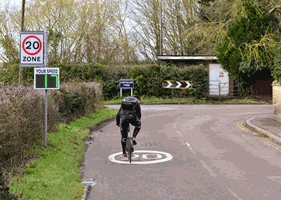
B
C
D
Correct Answer: D
Explanation: Make allowances for cyclists. Allow them plenty of room, and be aware that they also have to deal with hazards. They might swerve or change direction suddenly to avoid uneven road surfaces.
Explanation: Make allowances for cyclists. Allow them plenty of room, and be aware that they also have to deal with hazards. They might swerve or change direction suddenly to avoid uneven road surfaces.
Correct Answer: C
Explanation: Continuous use of the brakes on a long downhill gradient can cause them to overheat and become ineffective. This is called brake fade. You should use a low gear to enable the engine's braking effect to help control your speed. Also use the vehicle's retarder, if fitted. As well as reducing the likelihood of brake fade, this helps to keep air pressure in the tanks.
Explanation: Continuous use of the brakes on a long downhill gradient can cause them to overheat and become ineffective. This is called brake fade. You should use a low gear to enable the engine's braking effect to help control your speed. Also use the vehicle's retarder, if fitted. As well as reducing the likelihood of brake fade, this helps to keep air pressure in the tanks.
Correct Answer: B
Explanation: In good dry conditions, you should leave a two-second gap between your vehicle and the one ahead. When the weather is bad, you'll have to keep a greater distance, because it will take you longer to stop. In wet weather it will take up to twice the distance; in icy weather this could increase to ten times as far.
Explanation: In good dry conditions, you should leave a two-second gap between your vehicle and the one ahead. When the weather is bad, you'll have to keep a greater distance, because it will take you longer to stop. In wet weather it will take up to twice the distance; in icy weather this could increase to ten times as far.
41. What might it mean if the driver of a lorry flashes their headlights while you're overtaking them?
Mark one answer
B
C
D
Correct Answer: C
Explanation: Never presume what someone means when they flash their headlights, as they might be signalling to someone else. Use your own judgement and wait until it's safe to complete your manoeuvre.
Explanation: Never presume what someone means when they flash their headlights, as they might be signalling to someone else. Use your own judgement and wait until it's safe to complete your manoeuvre.
Correct Answer: D
Explanation: Drinking alcohol will reduce your ability to drive safely. One drink is too many if you're going to drive.
Explanation: Drinking alcohol will reduce your ability to drive safely. One drink is too many if you're going to drive.
Correct Answer: D
Explanation: Trams are becoming increasingly common in large towns and cities, as the move to more environmentally friendly transport continues. They may either cross the road you're driving on or share it with you. Always be aware of their virtually silent approach, and look out for places where you may be required to give way to them.
Explanation: Trams are becoming increasingly common in large towns and cities, as the move to more environmentally friendly transport continues. They may either cross the road you're driving on or share it with you. Always be aware of their virtually silent approach, and look out for places where you may be required to give way to them.
44. How could a tyre blow-out on your vehicle be potentially hazardous for other drivers?
Mark one answer
B
C
D
Correct Answer: A
Explanation: When a tyre explodes, fragments are thrown over a wide area. This can create a serious hazard for other drivers. You should regularly check your tyres for cuts, damage and pressure. Frequent checks and proper maintenance can help prevent a blow-out.
Explanation: When a tyre explodes, fragments are thrown over a wide area. This can create a serious hazard for other drivers. You should regularly check your tyres for cuts, damage and pressure. Frequent checks and proper maintenance can help prevent a blow-out.
Correct Answer: D
Explanation: The entrances to roundabouts are often worn. This can make the surface slippery, especially when it's wet. You should plan your approach and brake in good time.
Explanation: The entrances to roundabouts are often worn. This can make the surface slippery, especially when it's wet. You should plan your approach and brake in good time.
46. What might happen if you begin to overtake another vehicle on an uphill gradient while driving a fully laden vehicle?
Mark one answer
B
C
D
Correct Answer: A
Explanation: Always plan well ahead before overtaking. Take into consideration the size of your vehicle and whether there's a gradient ahead. The load on your vehicle will slow you down on an uphill gradient. It may be better to wait until you're on the level before trying to overtake.
Explanation: Always plan well ahead before overtaking. Take into consideration the size of your vehicle and whether there's a gradient ahead. The load on your vehicle will slow you down on an uphill gradient. It may be better to wait until you're on the level before trying to overtake.
47. Which of the following can you refer to for help with carrying out minor repairs to your vehicle?
Mark one answer
B
C
D
Correct Answer: C
Explanation: The vehicle handbook will clearly explain what maintenance may be carried out by the driver. Always refer to it and comply with the safety guidance that it contains. However, you need to be aware of your employer's policy on making any minor repairs.
Explanation: The vehicle handbook will clearly explain what maintenance may be carried out by the driver. Always refer to it and comply with the safety guidance that it contains. However, you need to be aware of your employer's policy on making any minor repairs.
48. For what reason can you sound your horn if you're in a built-up area between 11.30 pm and 7.00 am?
Mark one answer
B
C
D
Correct Answer: D
Explanation: The horn shouldn't be used between 11.30 pm and 7.00 am in a built-up area. The only exception is when another road user is unaware of you and poses a danger.
Explanation: The horn shouldn't be used between 11.30 pm and 7.00 am in a built-up area. The only exception is when another road user is unaware of you and poses a danger.
49. How should you approach a zebra crossing which has a disabled pedestrian waiting to cross?
Mark one answer
B
C
D
Correct Answer: C
Explanation: Prepare to slow down and stop, as you would for a person without a disability. Don't wave them across, as other traffic may not stop.
Explanation: Prepare to slow down and stop, as you would for a person without a disability. Don't wave them across, as other traffic may not stop.
50. What should you do if there is a slow-moving but unpredictable motorcyclist riding in front of you?
Mark one answer
B
C
D
Correct Answer: D
Explanation: The motorcyclist might be turning right, changing direction or unsure of their destination. Stay behind until the rider has made a move or you're sure you can pass safely. Don't intimidate them by moving too close.
Explanation: The motorcyclist might be turning right, changing direction or unsure of their destination. Stay behind until the rider has made a move or you're sure you can pass safely. Don't intimidate them by moving too close.
Correct Answer: A
Explanation: Parking on the yellow zigzag lines will block the view of the school entrance. This will endanger the lives of children wanting to cross the road on their way to and from school.
Explanation: Parking on the yellow zigzag lines will block the view of the school entrance. This will endanger the lives of children wanting to cross the road on their way to and from school.
Correct Answer: B
Explanation: Smart motorways are intended to reduce congestion and make journey times more reliable. In these areas, the hard shoulder may be used as a running lane to ease congestion at peak times or when an incident occurs. The variable speed limits shown in red circles are mandatory and help to keep traffic flowing at a steady speed.
Explanation: Smart motorways are intended to reduce congestion and make journey times more reliable. In these areas, the hard shoulder may be used as a running lane to ease congestion at peak times or when an incident occurs. The variable speed limits shown in red circles are mandatory and help to keep traffic flowing at a steady speed.
Correct Answer: A
Explanation: When a smart motorway is in operation, you must follow the instructions shown on the gantries above each lane. There may also be instructions above the hard shoulder. The signals displayed are mandatory and may be enforced with camera technology.
Explanation: When a smart motorway is in operation, you must follow the instructions shown on the gantries above each lane. There may also be instructions above the hard shoulder. The signals displayed are mandatory and may be enforced with camera technology.
Correct Answer: B
Explanation: Print or write down your route before setting out. Some places aren't well signed, so using both place names and road numbers may help you avoid getting lost. Find out how far you'll be travelling and plan your rest stops into the route.
Explanation: Print or write down your route before setting out. Some places aren't well signed, so using both place names and road numbers may help you avoid getting lost. Find out how far you'll be travelling and plan your rest stops into the route.
Correct Answer: B
Explanation: By driving smoothly, you'll reduce fuel consumption by about 15%, and you'll reduce the amount of wear and tear on your vehicle. You'll also feel more relaxed and have a more pleasant journey.
Explanation: By driving smoothly, you'll reduce fuel consumption by about 15%, and you'll reduce the amount of wear and tear on your vehicle. You'll also feel more relaxed and have a more pleasant journey.
Correct Answer: B
Explanation: If convicted, the current fine for each illegal immigrant brought into the UK is £2000. This fine can be imposed on each responsible person; this includes the vehicle driver, owner and hirer.
Explanation: If convicted, the current fine for each illegal immigrant brought into the UK is £2000. This fine can be imposed on each responsible person; this includes the vehicle driver, owner and hirer.
Correct Answer: A
Explanation: Being as healthy and alert as possible will make you safer on the road. Take regular meal and rest breaks, and keep to foods that contain complex carbohydrates, such as bread and vegetables. These release energy slowly and will keep you satisfied for longer than foods with a high sugar content.
Explanation: Being as healthy and alert as possible will make you safer on the road. Take regular meal and rest breaks, and keep to foods that contain complex carbohydrates, such as bread and vegetables. These release energy slowly and will keep you satisfied for longer than foods with a high sugar content.
Correct Answer: A
Explanation: Concentration will be improved by eating regular, light meals timed to fit in with your scheduled rest periods. If you don't eat at all, your blood sugar levels will drop and you'll feel tired. If you just eat snack foods, most of which are sugary or high in fat, your energy levels will peak and then drop - and eating while you're driving is a dangerous distraction.
Explanation: Concentration will be improved by eating regular, light meals timed to fit in with your scheduled rest periods. If you don't eat at all, your blood sugar levels will drop and you'll feel tired. If you just eat snack foods, most of which are sugary or high in fat, your energy levels will peak and then drop - and eating while you're driving is a dangerous distraction.
59. What type of digital tachograph card do police and law enforcement officers have unlimited access to?
Mark one answer
B
C
D
Correct Answer: B
Explanation: Various types of smart card are used in digital tachograph systems:
Explanation: Various types of smart card are used in digital tachograph systems:
- driver card, used by drivers
- company card, used by operators
- workshop card, available only to approved calibration centres
- control card, available only to Driver and Vehicle Standards Agency (DVSA) officials and the police, for carrying out enforcement.
60. Which of the following might be inspected by the environmental health department during a roadside check?
Mark one answer
B
Correct Answer: B
Explanation: Local-authority environmental health departments check vehicles' exhaust emissions. They have the power to prosecute the driver and the operator, as do enforcement bodies such as DVSA.
Explanation: Local-authority environmental health departments check vehicles' exhaust emissions. They have the power to prosecute the driver and the operator, as do enforcement bodies such as DVSA.
Correct Answer: A
Explanation: Driving in an ecosafe manner means that you plan well ahead for hazards and react in good time. This can save fuel and is therefore good for the environment.
Explanation: Driving in an ecosafe manner means that you plan well ahead for hazards and react in good time. This can save fuel and is therefore good for the environment.
62. In which of these circumstances would it be permissible to drive without a seat belt?
Mark one answer
B
C
D
Correct Answer: B
Explanation: When seat belts are fitted to your vehicle, they must be worn unless you hold a valid medical exemption certificate. People making deliveries or collections in goods vehicles are also exempt, when they're travelling less than 50 metres (162 feet).
Explanation: When seat belts are fitted to your vehicle, they must be worn unless you hold a valid medical exemption certificate. People making deliveries or collections in goods vehicles are also exempt, when they're travelling less than 50 metres (162 feet).
B
C
D
Correct Answer: D
Explanation: Using air conditioning continuously can increase fuel consumption by about 15%. Think of the environment and only use it when it's necessary.
Explanation: Using air conditioning continuously can increase fuel consumption by about 15%. Think of the environment and only use it when it's necessary.
64. What should you do with your tachograph chart if you move from one vehicle to another with the same type of tachograph?
Mark one answer
B
C
D
Correct Answer: C
Explanation: When changing vehicles, you should also record certain pieces of information, including the closing odometer reading, the registration number of the new vehicle, the odometer start reading and the time of the vehicle change.
Explanation: When changing vehicles, you should also record certain pieces of information, including the closing odometer reading, the registration number of the new vehicle, the odometer start reading and the time of the vehicle change.
65. How often should an analogue tachograph be inspected at an approved tachograph calibration centre?
Mark one answer
B
C
D
Correct Answer: C
Explanation: An analogue tachograph must be checked every two years and recalibrated and sealed every six years. This must be done at an approved calibration centre. Digital tachographs, unlike analogue ones, must be recalibrated every two years.
Explanation: An analogue tachograph must be checked every two years and recalibrated and sealed every six years. This must be done at an approved calibration centre. Digital tachographs, unlike analogue ones, must be recalibrated every two years.
66. Which of the following vehicles would be most at risk from strong winds on a motorway?
Mark one answer
B
C
D
Correct Answer: C
Explanation: Motorcycles can be very vulnerable to strong side wind. Allow extra room when overtaking them in windy weather. Check your nearside mirror while alongside and before moving back to the left.
Explanation: Motorcycles can be very vulnerable to strong side wind. Allow extra room when overtaking them in windy weather. Check your nearside mirror while alongside and before moving back to the left.
Correct Answer: A
Explanation: Water is the ideal drink, because it quenches your thirst for longer than tea or coffee. It's a good idea to carry water when you're driving, especially in very hot weather. The medical profession recommends that you drink 1.5 to 2 litres of water per day.
Explanation: Water is the ideal drink, because it quenches your thirst for longer than tea or coffee. It's a good idea to carry water when you're driving, especially in very hot weather. The medical profession recommends that you drink 1.5 to 2 litres of water per day.
68. How many days can a driver normally use a smart card for before further use will result in information being overwritten?
Mark one answer
B
C
D
Correct Answer: D
Explanation: The smart card will record information covering a period of about 28 days. If you use it beyond this period, some of the recorded information will be overwritten.
Explanation: The smart card will record information covering a period of about 28 days. If you use it beyond this period, some of the recorded information will be overwritten.
69. What must you show to an immigration officer if you are re-entering the UK and asked for your documentation?
Mark one answer
B
C
D
Correct Answer: C
Explanation: Operators must set up an 'effective system' to prevent the carriage of illegal immigrants. This should include documentation with advice on vehicle security and a list of checks to be made. These papers should be produced immediately if an immigration officer asks to see them.
Explanation: Operators must set up an 'effective system' to prevent the carriage of illegal immigrants. This should include documentation with advice on vehicle security and a list of checks to be made. These papers should be produced immediately if an immigration officer asks to see them.
70. How often must you do periodic training to keep your Driver Certificate of Professional Competence (CPC)?
Mark one answer
B
C
D
Correct Answer: C
Explanation: You must take 35 hours of training every five years to maintain your Driver CPC. This can be done at any time during the five years: all at once or split into sessions of at least seven hours each. The penalties for non-compliance are the same as those for driving without a licence.
Explanation: You must take 35 hours of training every five years to maintain your Driver CPC. This can be done at any time during the five years: all at once or split into sessions of at least seven hours each. The penalties for non-compliance are the same as those for driving without a licence.
71. Within how many days must you apply for a replacement smart card if you've list or damaged your smart card?
Mark one answer
B
C
D
Correct Answer: B
Explanation: As a professional driver, you have a responsibility to report any loss or theft of your digital smart card. You must inform the nearest relevant authority within seven days.
Explanation: As a professional driver, you have a responsibility to report any loss or theft of your digital smart card. You must inform the nearest relevant authority within seven days.
Correct Answer: B
Explanation: On a hot day, the fuel in your tank will expand. If this happens when the tank has been filled to the brim, fuel will spill onto the road. This can be very dangerous or even fatal for other road users - especially motorcyclists. Allow for this expansion when filling your tank.
Explanation: On a hot day, the fuel in your tank will expand. If this happens when the tank has been filled to the brim, fuel will spill onto the road. This can be very dangerous or even fatal for other road users - especially motorcyclists. Allow for this expansion when filling your tank.
73. Roughly what portion of accidents resulting from driver fatigue involve commercial vehicles?
Mark one answer
B
C
D
Correct Answer: B
Explanation: Research shows that approximately 40% of SRVIs involve commercial vehicles. The consequences are usually very serious because of the size of the vehicle and the fact that there is no braking before the impact.
Explanation: Research shows that approximately 40% of SRVIs involve commercial vehicles. The consequences are usually very serious because of the size of the vehicle and the fact that there is no braking before the impact.
Correct Answer: C
Explanation: While you're using a phone, your attention will be divided between the call and the road. This means you're unable to take in all that's happening around your vehicle. You need to be concentrating on your driving all of the time, and especially when dealing with a hazard.
Explanation: While you're using a phone, your attention will be divided between the call and the road. This means you're unable to take in all that's happening around your vehicle. You need to be concentrating on your driving all of the time, and especially when dealing with a hazard.
Correct Answer: B
Explanation: As the lubricating oil is pumped around the engine, it collects tiny fragments of metal from the moving parts. The oil filter is designed to remove these fragments. Most filters are designed to be replaced at service intervals.
Explanation: As the lubricating oil is pumped around the engine, it collects tiny fragments of metal from the moving parts. The oil filter is designed to remove these fragments. Most filters are designed to be replaced at service intervals.
Correct Answer: A
Explanation: If you're in a collision, a properly adjusted head restraint can help to reduce the risk of neck injury. However, an incorrectly adjusted head restraint could worsen any damage to your neck.
Explanation: If you're in a collision, a properly adjusted head restraint can help to reduce the risk of neck injury. However, an incorrectly adjusted head restraint could worsen any damage to your neck.
Correct Answer: B
Explanation: Driving at a constant speed for long periods, such as on a motorway, can cause drowsiness. Falling asleep while driving accounts for a significant proportion of vehicle incidents. You should plan and take regular rest stops, but if you feel the onset of tiredness between these breaks, stop and rest in a safe place.
Explanation: Driving at a constant speed for long periods, such as on a motorway, can cause drowsiness. Falling asleep while driving accounts for a significant proportion of vehicle incidents. You should plan and take regular rest stops, but if you feel the onset of tiredness between these breaks, stop and rest in a safe place.
B
C
D
Correct Answer: A
Explanation: In Great Britain, a replacement smart card can only be obtained from the Driver and Vehicle Licensing Agency (DVLA). In Northern Ireland, they're available from the Driver and Vehicle Agency (DVA).
Explanation: In Great Britain, a replacement smart card can only be obtained from the Driver and Vehicle Licensing Agency (DVLA). In Northern Ireland, they're available from the Driver and Vehicle Agency (DVA).
Correct Answer: B
Explanation: You must be aware of the maximum authorised mass (MAM) of your vehicle. This refers to its total weight, including both passengers and luggage. Fifteen passengers would add approximately 1 tonne to the weight of your vehicle. You should also allow for any luggage that they may be carrying.
Explanation: You must be aware of the maximum authorised mass (MAM) of your vehicle. This refers to its total weight, including both passengers and luggage. Fifteen passengers would add approximately 1 tonne to the weight of your vehicle. You should also allow for any luggage that they may be carrying.
B
C
D
Correct Answer: C
Explanation: Don't be tempted to drive on the limiter when using dual carriageway roads. The speed limit for passenger-carrying vehicles is 60 mph. Be considerate to faster-moving traffic by not using the middle or outside lanes unnecessarily.
Explanation: Don't be tempted to drive on the limiter when using dual carriageway roads. The speed limit for passenger-carrying vehicles is 60 mph. Be considerate to faster-moving traffic by not using the middle or outside lanes unnecessarily.
81. How long must a bus driver take a break for after driving continuously for the maximum period under the EU drivers' hours rules?
Mark one answer
B
C
D
Correct Answer: B
Explanation: After a driving for a period of no more than 4.5 hours, you must take a break of at least 45 minutes, which mustn't be interrupted. If you're carrying passengers, they'll probably also be grateful for a break. Taking breaks at the correct time will keep you and your passengers safe and comfortable.
Explanation: After a driving for a period of no more than 4.5 hours, you must take a break of at least 45 minutes, which mustn't be interrupted. If you're carrying passengers, they'll probably also be grateful for a break. Taking breaks at the correct time will keep you and your passengers safe and comfortable.
Correct Answer: A
Explanation: Check your nearside external and internal mirrors before you move away, in case anyone is attempting to board or leave your vehicle. Always give passengers time to be seated safely before you move away.
Explanation: Check your nearside external and internal mirrors before you move away, in case anyone is attempting to board or leave your vehicle. Always give passengers time to be seated safely before you move away.
Correct Answer: B
Explanation: If you're carrying children on your vehicle and it isn't on a scheduled route used by the general public, the bus must display this sign to the front and rear. When carrying children to and from school, it's likely that you'll have to make several stops in places other than recognised bus stops. Think carefully before you stop. Don't cause unnecessary inconvenience to other road users.
Explanation: If you're carrying children on your vehicle and it isn't on a scheduled route used by the general public, the bus must display this sign to the front and rear. When carrying children to and from school, it's likely that you'll have to make several stops in places other than recognised bus stops. Think carefully before you stop. Don't cause unnecessary inconvenience to other road users.
84. Why should you switch off your engine when you're stationary in traffic for some time?
Mark one answer
B
C
D
Correct Answer: C
Explanation: When you're stationary for any length of time (for example, in a traffic jam), switch off your engine. This will cut exhaust emissions and so help to protect the environment.
Explanation: When you're stationary for any length of time (for example, in a traffic jam), switch off your engine. This will cut exhaust emissions and so help to protect the environment.
B
C
D
Correct Answer: A
Explanation: Avoid using air-conditioning systems for long periods, as they can increase fuel consumption by about 15%. Try to drive with fuel economy and the environment in mind.
Explanation: Avoid using air-conditioning systems for long periods, as they can increase fuel consumption by about 15%. Try to drive with fuel economy and the environment in mind.
86. How could you help a passenger with a mobility problem that has just boarded your bus?
Mark one answer
B
C
D
Correct Answer: D
Explanation: Try to wait until your passengers have sat down before you move off. This is even more important if they're elderly or have difficulty walking. Offer help when you think it might be needed - and remember, a smile goes a long way.
Explanation: Try to wait until your passengers have sat down before you move off. This is even more important if they're elderly or have difficulty walking. Offer help when you think it might be needed - and remember, a smile goes a long way.
Correct Answer: A
Explanation: You should always allow engines fitted with turbochargers to idle for about a minute before stopping the engine. This prevents the turbine bearings from being starved of oil.
Explanation: You should always allow engines fitted with turbochargers to idle for about a minute before stopping the engine. This prevents the turbine bearings from being starved of oil.
88. Which of the following may be out of sight if your bus has a high seating position?
Mark one answer
B
C
D
Correct Answer: C
Explanation: If you've been stopped for some time at a bus stop or in a bus station, be aware that cyclists and pedestrians, especially children, can enter your blind spots. They may be out of sight below the windscreen line. Always take all-round observation before manoeuvring, whether you're moving away, parking or reversing.
Explanation: If you've been stopped for some time at a bus stop or in a bus station, be aware that cyclists and pedestrians, especially children, can enter your blind spots. They may be out of sight below the windscreen line. Always take all-round observation before manoeuvring, whether you're moving away, parking or reversing.
Correct Answer: D
Explanation: Every vehicle fitted with anti-lock brakes must have a warning light in the cab of the vehicle. The warnings may differ between manufacturers, but on all types the warning light should come on when the ignition is switched on, and turn off when the vehicle reaches a speed of 6 mph (10 km/h). If the light stays on, there may be a fault; you should have the brakes checked before continuing your journey.
Explanation: Every vehicle fitted with anti-lock brakes must have a warning light in the cab of the vehicle. The warnings may differ between manufacturers, but on all types the warning light should come on when the ignition is switched on, and turn off when the vehicle reaches a speed of 6 mph (10 km/h). If the light stays on, there may be a fault; you should have the brakes checked before continuing your journey.
90. What should you do if passengers tell you they can smell exhaust smoke in the bus?
Mark one answer
B
C
D
Correct Answer: C
Explanation: If exhaust fumes are getting into the vehicle, this could be a danger to your passengers. Stop as soon as it's safe to do so and have the fault put right before continuing.
Explanation: If exhaust fumes are getting into the vehicle, this could be a danger to your passengers. Stop as soon as it's safe to do so and have the fault put right before continuing.
Correct Answer: B
Explanation: Make sure that your vehicle displays all the information required by law (the 'legal lettering'): the seating/standing capacity and the locations of the emergency exit, fuel cut-off switch and electrical isolator.
Explanation: Make sure that your vehicle displays all the information required by law (the 'legal lettering'): the seating/standing capacity and the locations of the emergency exit, fuel cut-off switch and electrical isolator.
Correct Answer: D
Explanation: Don't park where you'll cause obstruction or inconvenience to other road users. It's an offence to leave your bus with the engine running and/or without applying the parking brake.
Explanation: Don't park where you'll cause obstruction or inconvenience to other road users. It's an offence to leave your bus with the engine running and/or without applying the parking brake.
Correct Answer: D
Explanation: Bus drivers have responsibilities beyond those of other drivers. Your passengers have paid for a service, and they should arrive at their chosen destination safely. Customers are more likely to travel with you again if they receive a safe, courteous and comfortable service.
Explanation: Bus drivers have responsibilities beyond those of other drivers. Your passengers have paid for a service, and they should arrive at their chosen destination safely. Customers are more likely to travel with you again if they receive a safe, courteous and comfortable service.
94. Why would you need to know if anybody is on the stairs when driving a double deck bus?
Mark one answer
B
C
D
Correct Answer: A
Explanation: You must always be aware of anyone using the stairs. Be particularly careful to avoid any sudden movement, such as when braking or cornering, as this could cause passengers to stumble.
Explanation: You must always be aware of anyone using the stairs. Be particularly careful to avoid any sudden movement, such as when braking or cornering, as this could cause passengers to stumble.
95. In what circumstance can you drive a bus at night without the interior lights turned on?
Mark one answer
B
C
D
Correct Answer: C
Explanation: Whenever passengers are on board, the interior lighting must be left on. It may be turned off when the bus is empty.
Explanation: Whenever passengers are on board, the interior lighting must be left on. It may be turned off when the bus is empty.
96. What should you do if a disabled passenger is boarding your bus but you can see they are struggling?
Mark one answer
B
C
D
Correct Answer: C
Explanation: Disabled people like to keep their independence. However, if they're having problems, be prepared to offer help.
Explanation: Disabled people like to keep their independence. However, if they're having problems, be prepared to offer help.
Correct Answer: D
Explanation: Bus stations are busy places. If people are in a rush, they may not always look properly before getting off a bus. Keep your speed down and look for manoeuvring vehicles or pedestrians stepping into your path.
Explanation: Bus stations are busy places. If people are in a rush, they may not always look properly before getting off a bus. Keep your speed down and look for manoeuvring vehicles or pedestrians stepping into your path.
98. Which of the following type of vehicle is sometimes allowed to drive in the bus lane?
Mark one answer
B
C
D
Correct Answer: D
Explanation: The bus-lane signs will indicate which road users are allowed to share the lane with buses and any time restrictions that may apply. Taxis are often allowed to use bus lanes, as these lanes provide a route that has less congestion and can therefore be quicker.
Explanation: The bus-lane signs will indicate which road users are allowed to share the lane with buses and any time restrictions that may apply. Taxis are often allowed to use bus lanes, as these lanes provide a route that has less congestion and can therefore be quicker.
Correct Answer: B
Explanation: The sign shows the maximum authorised mass for goods vehicles. It's used to restrict heavy lorries (for example, in residential areas), but it doesn't apply to buses and coaches.
Explanation: The sign shows the maximum authorised mass for goods vehicles. It's used to restrict heavy lorries (for example, in residential areas), but it doesn't apply to buses and coaches.
100. Under what circumstance might you be unable to allow a wheelchair user to enter you bus?
Mark one answer
B
C
D
Correct Answer: B
Explanation: If a wheelchair space is occupied by standing passengers and luggage, you might not be able to allow a wheelchair user on the bus. This may occur on a bus that's almost full to capacity. You won't have failed in your statutory duties towards the wheelchair user.
Explanation: If a wheelchair space is occupied by standing passengers and luggage, you might not be able to allow a wheelchair user on the bus. This may occur on a bus that's almost full to capacity. You won't have failed in your statutory duties towards the wheelchair user.



